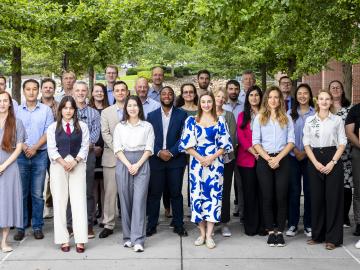
Filter News
Area of Research
- Advanced Manufacturing (2)
- Biological Systems (1)
- Biology and Environment (32)
- Clean Energy (32)
- Computational Biology (2)
- Computational Engineering (2)
- Computer Science (3)
- Electricity and Smart Grid (1)
- Functional Materials for Energy (1)
- Fusion and Fission (9)
- Fusion Energy (8)
- Isotopes (6)
- Materials (30)
- Materials for Computing (5)
- Mathematics (1)
- National Security (22)
- Neutron Science (22)
- Nuclear Science and Technology (14)
- Nuclear Systems Modeling, Simulation and Validation (1)
- Quantum information Science (9)
- Supercomputing (75)
News Topics
- (-) Advanced Reactors (34)
- (-) Biomedical (61)
- (-) Clean Water (31)
- (-) Cybersecurity (35)
- (-) Education (5)
- (-) Frontier (45)
- (-) Quantum Science (72)
- (-) Statistics (3)
- 3-D Printing/Advanced Manufacturing (128)
- Artificial Intelligence (101)
- Big Data (60)
- Bioenergy (92)
- Biology (101)
- Biotechnology (24)
- Buildings (67)
- Chemical Sciences (73)
- Climate Change (105)
- Composites (30)
- Computer Science (198)
- Coronavirus (46)
- Critical Materials (29)
- Decarbonization (85)
- Element Discovery (1)
- Emergency (2)
- Energy Storage (112)
- Environment (200)
- Exascale Computing (42)
- Fossil Energy (6)
- Fusion (58)
- Grid (66)
- High-Performance Computing (93)
- Hydropower (11)
- Irradiation (3)
- Isotopes (57)
- ITER (7)
- Machine Learning (50)
- Materials (147)
- Materials Science (146)
- Mathematics (9)
- Mercury (12)
- Microelectronics (4)
- Microscopy (51)
- Molten Salt (9)
- Nanotechnology (60)
- National Security (72)
- Net Zero (14)
- Neutron Science (137)
- Nuclear Energy (111)
- Partnerships (51)
- Physics (64)
- Polymers (33)
- Quantum Computing (37)
- Renewable Energy (2)
- Security (25)
- Simulation (51)
- Software (1)
- Space Exploration (25)
- Summit (59)
- Sustainable Energy (130)
- Transformational Challenge Reactor (7)
- Transportation (99)
Media Contacts

Three flights, five thousand miles and half a dozen clearances and permissions stood between Tetiana Maltseva and the Department of Energy’s Oak Ridge National Laboratory. When she finally arrived at the lab to represent Ukraine at the 2024 Nuclear Energy Management School, her vision was clear.

For the first time, ORNL will run equipment developed at its research facilities on a commercially available quantum network at EPB Quantum Network powered by Qubitekk to help validate the technology's commercial viability.
After retiring from Y-12, Scott Abston joined the Isotope Science and Engineering Directorate to support isotope production and work with his former manager. He now leads a team maintaining critical equipment for medical and space applications. Abston finds fulfillment in mentoring his team and is pleased with his decision to continue working.

Nuclear physicists at the Department of Energy’s Oak Ridge National Laboratory recently used Frontier, the world’s most powerful supercomputer, to calculate the magnetic properties of calcium-48’s atomic nucleus.

A study by more than a dozen scientists at the Department of Energy’s Oak Ridge National Laboratory examines potential strategies to integrate quantum computing with the world’s most powerful supercomputing systems in the pursuit of science.

Jeremiah Sewell leads a team at ORNL, working on xenon-129 production for lung imaging. Reflecting on his career, Sewell views each opportunity as a "door" he steps through, leveraging over 25 years of experience in nuclear power and centrifuge operations to advance the facility’s mission.

Debjani Singh, a senior scientist at ORNL, leads the HydroSource project, which enhances hydropower research by making water data more accessible and useful. With a background in water resources, data science, and earth science, Singh applies innovative tools like AI to advance research. Her career, shaped by her early exposure to science in India, focuses on bridging research with practical applications.

At ORNL, a group of scientists used neutron scattering techniques to investigate a relatively new functional material called a Weyl semimetal. These Weyl fermions move very quickly in a material and can carry electrical charge at room temperature. Scientists think that Weyl semimetals, if used in future electronics, could allow electricity to flow more efficiently and enable more energy-efficient computers and other electronic devices.

The world’s fastest supercomputer helped researchers simulate synthesizing a material harder and tougher than a diamond — or any other substance on Earth. The study used Frontier to predict the likeliest strategy to synthesize such a material, thought to exist so far only within the interiors of giant exoplanets, or planets beyond our solar system.

Brian Sanders is focused on impactful, multidisciplinary science at Oak Ridge National Laboratory, developing solutions for everything from improved imaging of plant-microbe interactions that influence ecosystem health to advancing new treatments for cancer and viral infections.


